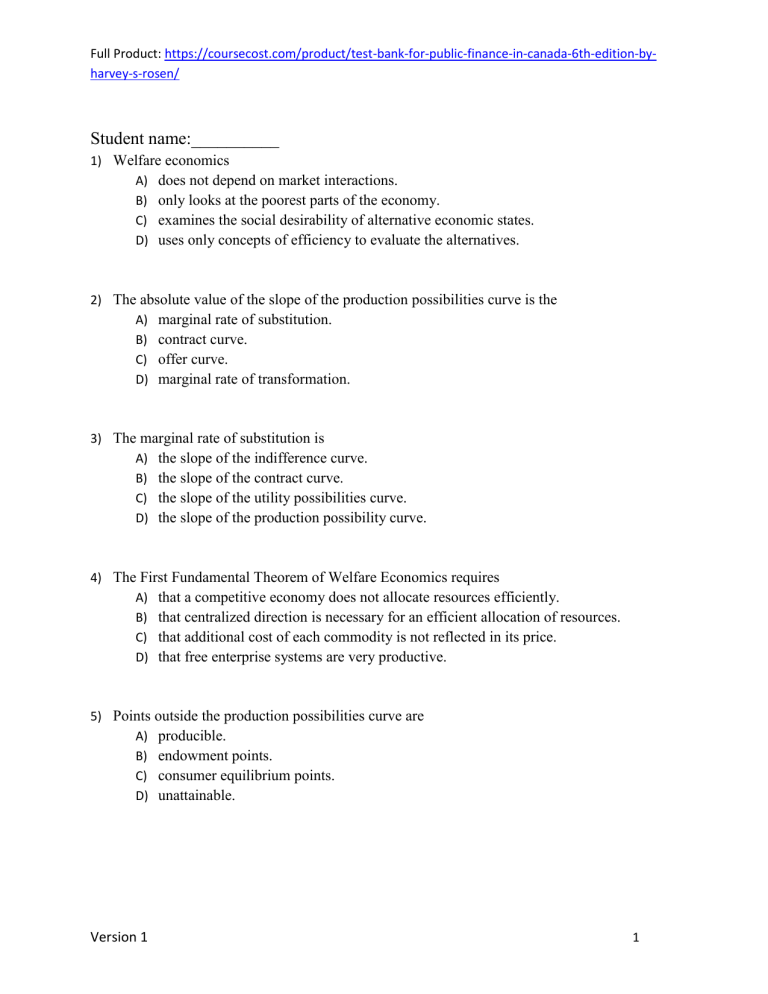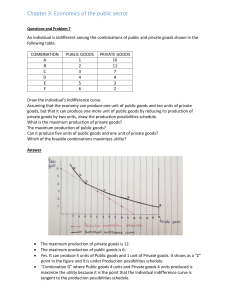
Full Product: https://coursecost.com/product/test-bank-for-public-finance-in-canada-6th-edition-byharvey-s-rosen/
Student name:__________
1) Welfare economics
A) does not depend on market interactions.
B) only looks at the poorest parts of the economy.
C) examines the social desirability of alternative economic states.
D) uses only concepts of efficiency to evaluate the alternatives.
2) The absolute value of the slope of the production possibilities curve is the
A) marginal rate of substitution.
B) contract curve.
C) offer curve.
D) marginal rate of transformation.
3) The marginal rate of substitution is
A) the slope of the indifference curve.
B) the slope of the contract curve.
C) the slope of the utility possibilities curve.
D) the slope of the production possibility curve.
4) The First Fundamental Theorem of Welfare Economics requires
A) that a competitive economy does not allocate resources efficiently.
B) that centralized direction is necessary for an efficient allocation of resources.
C) that additional cost of each commodity is not reflected in its price.
D) that free enterprise systems are very productive.
5) Points outside the production possibilities curve are
A) producible.
B) endowment points.
C) consumer equilibrium points.
D) unattainable.
Version 1
1
Full Product: https://coursecost.com/product/test-bank-for-public-finance-in-canada-6th-edition-byharvey-s-rosen/
6) Market failure can occur when
A) firms are not price makers.
B) a market for a commodity does not exist.
C) individuals are not price makers
D) producers and consumers act as perfect competitors.
7) A public good is
A) a good that the public must pay for.
B) nonexcludable and nonrival in consumption.
C) excludable and rival in consumption.
D) always provided by the government.
8) Merit goods
A) are provided for those who are well behaved and earn them.
B) should be provided even if there is no demand for them.
C) increase in costs as demand increases.
D) should be provided if the demand for this good is very high.
9) A social welfare function
A) is a function made by the Department of Welfare.
B) depends on the utilities of each of its members.
C) can never be derived numerically.
D) depends only on the utilities of the wealthy people of the society
10) Movement from an inefficient allocation to an efficient allocation in the Edgeworth Box will
A) increase the utility of all individuals.
B) increase the utility of at least one individual, but may decrease the level of utility of
another person.
C) increase the utility of one individual, but cannot decrease the utility of any individual.
D) decrease the utility of all individuals.
Version 1
2
Full Product: https://coursecost.com/product/test-bank-for-public-finance-in-canada-6th-edition-byharvey-s-rosen/
11) Points on the utility possibilities curve are
A) inefficient.
B) points of incomplete preferences.
C) not producible.
D) Pareto efficient.
12) The Edgeworth Box should
A) lie inside the production possibilities curve.
B) lie partially inside the production possibilities curve.
C) lie completely outside of the production possibilities curve.
D) never touch the production possibilities curve.
13) Pareto efficient points in the Edgeworth Box are
A) found when indifference curves intersect.
B) found when MRS are not equal.
C) found when one person cannot be made better off without making another person
worse off.
D) found when indifference curves lie outside the Edgeworth Box
14) According to the Second Fundamental Theorem of Welfare Economics,
A) society can attain any Pareto efficient allocation of resources.
B) not all points along the utility possibilities curve are attainable.
C) equity cannot be achieved without inhibiting efficiency.
D) production must be twice as large as consumption.
15) Welfare economics is concerned with individual desirability of alternative economic states.
A) True
B) False
Version 1
3
Full Product: https://coursecost.com/product/test-bank-for-public-finance-in-canada-6th-edition-byharvey-s-rosen/
16) The contract curve is the collection of points where indifference curves are tangent in the
Edgeworth box.
A) True
B) False
17) The utility possibilities curve is derived from the contract curve.
A) True
B) False
18) When the First Fundamental Theorem of Welfare Economics doesn't hold, there is a market
failure.
A) True
B) False
19) An example of an activity that generates an externality is pursuing a graduate degree in
economics.
A) True
B) False
20) Social indifference curves are the same as a social welfare function.
A) True
B) False
21) A utility possibilities curve need not incorporate the utility of every individual.
A) True
B) False
22) For Pareto efficiency, the MRT should not equal the MRS of all individuals.
A) True
B) False
Version 1
4
Full Product: https://coursecost.com/product/test-bank-for-public-finance-in-canada-6th-edition-byharvey-s-rosen/
23) The government must intervene in markets in order to move the economy to the welfare
maximizing point.
A) True
B) False
24) There is only one Pareto efficient point on the contract curve.
A) True
B) False
25) Marginal cost is the incremental production cost of one more unit of output.
A) True
B) False
26) Pareto improvement can be a reallocation of resources that makes more than one person
better off.
A) True
B) False
27) Consider an Edgeworth economy where there are two citizens, Mr. Cortopassi and Ms.
Thomas. There are only two goods to be consumed in the economy, Beer and Pretzels. The
total amount of Beer is 12 units. The total amount of Pretzels is 12 units. Answer the
following: Suppose Mr. Cortopassi has utility for the two goods characterized as UC(B,P) =
B + P. Ms. Thomas's utility function is UT(B,P) = B + P. Identify the points that are Pareto
efficient.
Version 1
5
Full Product: https://coursecost.com/product/test-bank-for-public-finance-in-canada-6th-edition-byharvey-s-rosen/
28) Imagine a simple economy with only two people, Leroy and Percy. If the social welfare
function is W = UL + UP, and the utility possibilities curve is UPF = UL + 2UP, what will be
the societal optimum?
29) If James has an indifference curve characterized by the function of U = 2X3 Y2, what is his
marginal rate of substitution of good X for good Y?
Version 1
6
Full Product: https://coursecost.com/product/test-bank-for-public-finance-in-canada-6th-edition-byharvey-s-rosen/
30) Consider a simple exchange economy where the marginal rate of transformation between two
goods is greater than the marginal rate of substitution for the same goods. Can the Pareto
equilibrium be derived?
31) Suppose that a competitive firm's marginal cost of producing output q is given by MC = 5 +
2q. Assume that the market price of the firm's product is $27. What level of output will the
firm produce?
32) Social welfare functions can be formed in many ways. They can be additive, meaning that all
utilities are added together. They can incorporate the idea of maximin, meaning that the
utility of the person with the least is maximized. If you were a central planner for an
economy, what type of social welfare function would you create?
33) Merit goods have been discussed towards the end of this chapter. Can concerts and other
publicly provided services be rationalized using these ideas?
Version 1
7
Full Product: https://coursecost.com/product/test-bank-for-public-finance-in-canada-6th-edition-byharvey-s-rosen/
34) Why might asymmetric information contribute to the problem of a market failure?
Version 1
8
Full Product: https://coursecost.com/product/test-bank-for-public-finance-in-canada-6th-edition-byharvey-s-rosen/
Answer Key
Test name: Chapter 02 Test Bank
1) C
2) D
3) A
4) D
5) D
6) D
7) B
8) B
9) B
10) B
11) D
12) A
13) C
14) A
15) B
16) A
17) A
18) A
19) A
20) A
21) A
22) B
23) B
24) B
25) A
26) A
27) Short Answer
28) Short Answer
29) Short Answer
30) Short Answer
31) Short Answer
32) Short Answer
33) Short Answer
34) Short Answer
Version 1
9




